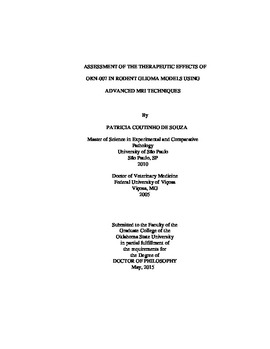| dc.contributor.advisor | Towner, Rheal A. | |
| dc.contributor.author | Coutinho de Souza, Patricia | |
| dc.date.accessioned | 2016-04-15T21:49:16Z | |
| dc.date.available | 2016-04-15T21:49:16Z | |
| dc.date.issued | 2015-05 | |
| dc.identifier.uri | https://hdl.handle.net/11244/33401 | |
| dc.description.abstract | Glioblastoma is a malignant grade IV glioma with a poor prognosis in humans. New therapeutics are desperately required. The nitrone OKN-007 (2,4-disulfophenyl-PBN) has demonstrated effective anti-glioma properties in several rodent models and is currently being used as a clinical investigational drug for recurrent gliomas. In this study, we assessed the efficacy of OKN-007 in two adult (rat F98 and mouse GL261) and one novel pediatric (IC-3752GBM in nude mice) high grade glioma model. OKN-007 significantly reduced the percent necrosis (p<0.01) and tumor cell proliferation (p<0.05) in treated F98-tumor bearing rats compared to the untreated group. Based on molecular magnetic resonance imaging (MRI) results, OKN-007 was also found to significantly decrease (p<0.05) free radicals levels in treated F98 rats compared to the untreated group. We also assessed VEGFR-2 (vascular endothelial growth factor receptor 2) levels in untreated and OKN-007-treated GL261 mouse gliomas using molecular MRI. OKN-007 decreased significantly the levels of VEGFR-2 (p<0.05) in GL261 gliomas compared to the untreated group. Furthermore, OKN-007 was also able to decrease significantly the tumor volumes (p<0.01) and increase survival (p< 0.001) in GL261 treated mice. For the pediatric glioma study, MRI results showed that OKN-007 significantly decreased tumor volumes (p<0.05), increased diffusion (p<0.01) and perfusion rates (p<0.05) in a responsive cohort of IC-3752GBM treated animals. In addition, OKN-007 significantly increased animal survival (p<0.05), decreased tumor cell proliferation (p<0.05) and microvessel density (p<0.05) in responsive IC-3752GBM treated mice. Furthermore, the nitrone was also able to significantly decrease the immunoexpression of SULF2 (p<0.05) and PDGFRa (platelet-derived growth factor receptor-a) (p<0.05), and significantly increase the expression of decorin (p<0.05) in responsive IC-3752GBM pGBM tumor bearing mice. Taken together, our findings showed that OKN-007 mediated multiple effects in different rodent glioma models, indicating that the efficacy associated with OKN-007 is a result of anti-proliferative, free radical scavenging, and anti-angiogenic properties. Furthermore, OKN-007 might be also an effective anti-cancer agent for some patients with pediatric gliomas, possibly by inhibiting the PDGFRa pathway, and could be considered as an additional therapy for pediatric brain tumor patients. | |
| dc.format | application/pdf | |
| dc.language | en_US | |
| dc.rights | Copyright is held by the author who has granted the Oklahoma State University Library the non-exclusive right to share this material in its institutional repository. Contact Digital Library Services at lib-dls@okstate.edu or 405-744-9161 for the permission policy on the use, reproduction or distribution of this material. | |
| dc.title | Assessment of the therapeutic effects of OKN-007 in rodent glioma models using advanced MRI techniques | |
| dc.contributor.committeeMember | Ritchey, Jerry W. | |
| dc.contributor.committeeMember | Breshears, Melanie | |
| dc.contributor.committeeMember | Ranjan, Ashish | |
| dc.contributor.committeeMember | Piao, Daqing | |
| dc.contributor.committeeMember | Mather, Timothy | |
| osu.filename | CoutinhodeSouza_okstate_0664D_13853.pdf | |
| osu.accesstype | Open Access | |
| dc.type.genre | Dissertation | |
| dc.type.material | Text | |
| thesis.degree.discipline | Veterinary Biomedical Sciences | |
| thesis.degree.grantor | Oklahoma State University | |
